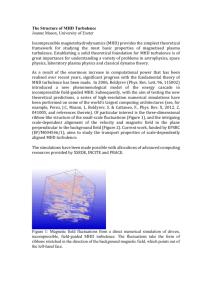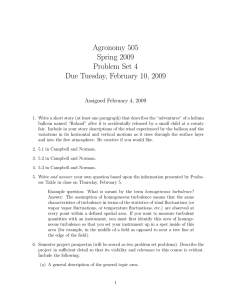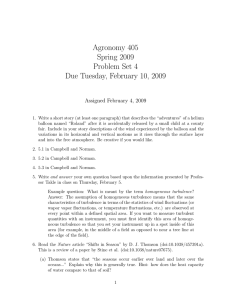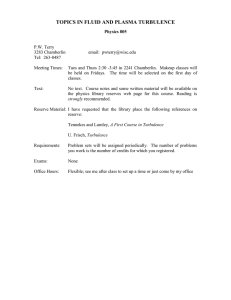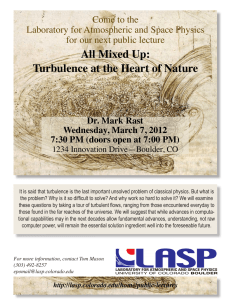Polarization Alignment in Driven
advertisement
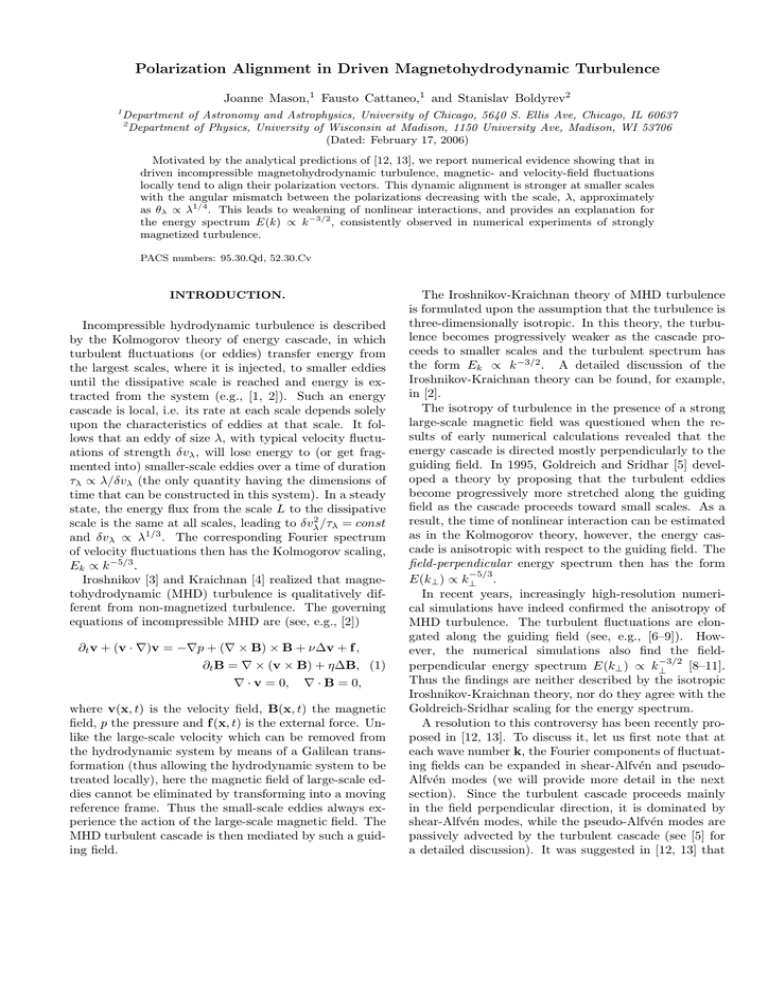
Polarization Alignment in Driven Magnetohydrodynamic Turbulence Joanne Mason,1 Fausto Cattaneo,1 and Stanislav Boldyrev2 1 Department of Astronomy and Astrophysics, University of Chicago, 5640 S. Ellis Ave, Chicago, IL 60637 2 Department of Physics, University of Wisconsin at Madison, 1150 University Ave, Madison, WI 53706 (Dated: February 17, 2006) Motivated by the analytical predictions of [12, 13], we report numerical evidence showing that in driven incompressible magnetohydrodynamic turbulence, magnetic- and velocity-field fluctuations locally tend to align their polarization vectors. This dynamic alignment is stronger at smaller scales with the angular mismatch between the polarizations decreasing with the scale, λ, approximately as θλ ∝ λ1/4 . This leads to weakening of nonlinear interactions, and provides an explanation for the energy spectrum E(k) ∝ k−3/2 , consistently observed in numerical experiments of strongly magnetized turbulence. PACS numbers: 95.30.Qd, 52.30.Cv INTRODUCTION. Incompressible hydrodynamic turbulence is described by the Kolmogorov theory of energy cascade, in which turbulent fluctuations (or eddies) transfer energy from the largest scales, where it is injected, to smaller eddies until the dissipative scale is reached and energy is extracted from the system (e.g., [1, 2]). Such an energy cascade is local, i.e. its rate at each scale depends solely upon the characteristics of eddies at that scale. It follows that an eddy of size λ, with typical velocity fluctuations of strength δvλ , will lose energy to (or get fragmented into) smaller-scale eddies over a time of duration τλ ∝ λ/δvλ (the only quantity having the dimensions of time that can be constructed in this system). In a steady state, the energy flux from the scale L to the dissipative scale is the same at all scales, leading to δvλ2 /τλ = const and δvλ ∝ λ1/3 . The corresponding Fourier spectrum of velocity fluctuations then has the Kolmogorov scaling, Ek ∝ k −5/3 . Iroshnikov [3] and Kraichnan [4] realized that magnetohydrodynamic (MHD) turbulence is qualitatively different from non-magnetized turbulence. The governing equations of incompressible MHD are (see, e.g., [2]) ∂t v + (v · ∇)v = −∇p + (∇ × B) × B + ν∆v + f , ∂t B = ∇ × (v × B) + η∆B, (1) ∇ · v = 0, ∇ · B = 0, where v(x, t) is the velocity field, B(x, t) the magnetic field, p the pressure and f (x, t) is the external force. Unlike the large-scale velocity which can be removed from the hydrodynamic system by means of a Galilean transformation (thus allowing the hydrodynamic system to be treated locally), here the magnetic field of large-scale eddies cannot be eliminated by transforming into a moving reference frame. Thus the small-scale eddies always experience the action of the large-scale magnetic field. The MHD turbulent cascade is then mediated by such a guiding field. The Iroshnikov-Kraichnan theory of MHD turbulence is formulated upon the assumption that the turbulence is three-dimensionally isotropic. In this theory, the turbulence becomes progressively weaker as the cascade proceeds to smaller scales and the turbulent spectrum has the form Ek ∝ k −3/2 . A detailed discussion of the Iroshnikov-Kraichnan theory can be found, for example, in [2]. The isotropy of turbulence in the presence of a strong large-scale magnetic field was questioned when the results of early numerical calculations revealed that the energy cascade is directed mostly perpendicularly to the guiding field. In 1995, Goldreich and Sridhar [5] developed a theory by proposing that the turbulent eddies become progressively more stretched along the guiding field as the cascade proceeds toward small scales. As a result, the time of nonlinear interaction can be estimated as in the Kolmogorov theory, however, the energy cascade is anisotropic with respect to the guiding field. The field-perpendicular energy spectrum then has the form −5/3 E(k⊥ ) ∝ k⊥ . In recent years, increasingly high-resolution numerical simulations have indeed confirmed the anisotropy of MHD turbulence. The turbulent fluctuations are elongated along the guiding field (see, e.g., [6–9]). However, the numerical simulations also find the field−3/2 perpendicular energy spectrum E(k⊥ ) ∝ k⊥ [8–11]. Thus the findings are neither described by the isotropic Iroshnikov-Kraichnan theory, nor do they agree with the Goldreich-Sridhar scaling for the energy spectrum. A resolution to this controversy has been recently proposed in [12, 13]. To discuss it, let us first note that at each wave number k, the Fourier components of fluctuating fields can be expanded in shear-Alfvén and pseudoAlfvén modes (we will provide more detail in the next section). Since the turbulent cascade proceeds mainly in the field perpendicular direction, it is dominated by shear-Alfvén modes, while the pseudo-Alfvén modes are passively advected by the turbulent cascade (see [5] for a detailed discussion). It was suggested in [12, 13] that 2 the polarizations of the shear-Alfvén magnetic-field and velocity-field fluctuations become spontaneously aligned in a turbulent cascade. This alignment becomes progressively stronger for smaller scales. It was proposed that at a given scale λ the directions of fluctuations δvλ and ±δbλ are aligned within the angle θλ ∝ λ1/4 . As in the Goldreich-Sridhar theory, the eddies are stretched along the guiding field. However, as a result of polarization alignment, they also become anisotropic in the field-perpendicular plane, and this anisotropy increases as the scale decreases. The resulting spectrum of field−3/2 perpendicular fluctuations is E(k⊥ ) ∝ k⊥ , in good agreement with the numerical results described above. As proposed in [12, 13], the reason for such a dynamic alignment is the existence of two conserved quantities in magnetohydrodynamics, whose cascades are directed toward small scales in a turbulent state. The MHD system (1) in the ideal limit ν = η = 0 conserves the integral of energy Z 1 E= (b2 + v 2 )d3 x, (2) 2 and the integral of cross-helicity, Z H C = (v · b)d3 x, (3) provided that the fluctuations v(x) and b(x) have periodic boundary conditions or vanish at infinity. The structure of turbulent fluctuations in the inertial region should accommodate constant fluxes of both conserved quantities. It was demonstrated in [12, 13] that the sole requirement of constant energy flux does not allow one to find the spectrum of the fluctuations uniquely. Rather, the alignment angle can be parameterized θλ ∝ λα/(3+α) , with a single parameter α ≥ 0. The parameter α is determined by the additional requirement of a constant flux of cross-helicity toward small scales. It was suggested in [13] that, in general, the rate of cross-helicity cascade is smaller than the rate of energy cascade. Therefore, the alignment of δvλ and δbλ is maximal under the constraint of a constant energy flux. This fixes the parameter uniquely, α = 1, and leads to the scaling of the alignment angle θλ ∝ λ1/4 . Interestingly, the effect of dynamic alignment has been extensively investigated before in the case of decaying MHD turbulence, where it essentially meant that decaying magnetic and velocity fields approached asymptotically in time the so-called Alfvénic state v(x) = ±b(x), e.g., [14–16]. However, decaying turbulence is qualitatively different from its forced counterpart, and the effects that we discuss in the present work have not been addressed in these early investigations. In the present paper we investigate the phenomenon of dynamic alignment via direct numerical simulations. We analyze driven incompressible MHD turbulence with a strong guiding magnetic field. We measure the degree to which the velocity and magnetic field fluctuations align as a function of scale and we also investigate the dependence on the strength of the imposed field. To the best of our knowledge this is the first time that the phenomenon of scale-dependent dynamic alignment has been observed in numerical simulations. DYNAMIC ALIGNMENT IN MHD TURBULENCE. We solve the MHD equations (1) using standard pseudospectral methods. An external magnetic field is applied in z direction with strength B0 measures in units of velocity. The periodic domain has a resolution of 2563 mesh points and is elongated in the z direction, with aspect ratio 1:1:B0 . The external force, f (x, t), is chosen so as to drive the turbulence at large scales and it satisfies the following requirements: it has no component along z, it is solenoidal in the x − y plane, all the Fourier coefficients outside the range 1 ≤ k ≤ 2 are zero, the Fourier coefficients inside that range are Gaussian random numbers with unit variance and amplitude chosen so that the resulting rms velocity fluctuations are of order unity, and the individual random values are refreshed independently on average every turnover time of the large scale eddies. The Reynolds number is defined as Re = Urms L/ν, where L is the field-perpendicular box size, ν is fluid viscosity, and Urms (∼ 1) is the rms value of velocity fluctuations. We restrict ourselves to the case in which magnetic resistivity and fluid viscosity are the same, ν = η. The system is evolved until a stationary state is reached (confirmed by observing the time evolution of the total energy of fluctuations) and the data are then sampled in intervals of order of the eddy turn-over time. All results presented correspond to averages over these samples (approx. 10 samples). First we measure the two-dimensional energy spectrum, defined as E(k⊥ ) = h|v(k⊥ )|2 ik⊥ + h|b(k⊥ )|2 ik⊥ , where v(k⊥ ) and b(k⊥ ) are two-dimensional Fourier transformations of the velocity and magnetic fields in a ¡ ¢1/2 plane perpendicular to B0 and k⊥ = kx2 + ky2 . The average is taken over all such planes in the data cube, and then over all data cubes. The resulting spectrum of fluctuations is presented in Fig. 1. It is impossible to infer the exponent of the power-law distribution with good accuracy here and in particular it is hard to distinguish between the spectral indices −5/3 and −3/2. As was demonstrated in [9, 10], a much higher resolution allows greater Reynolds numbers to be explored and yields a longer inertial range. Since recent high resolution calcu−3/2 lations do yield E(k⊥ ) ∼ k⊥ (see [8–11]) we choose not to pursue this issue further here. Instead we concentrate our study on the effect of dynamic alignment that, as we shall demonstrate presently, can be observed well 3 FIG. 1: Two-dimensional spectrum of MHD turbulence in the plane perpendicular to the guiding field B0 . The numerical resolution is 2563 , the Reynolds number is Re = 800, and the strength of the uniform guiding field is B0 = 5. The turbulence is driven by a solenoidal random force at wave numbers k = 1, 2, as is explained in the text. even with limited resolution. To investigate the dynamic alignment of the shearAlfvén fluctuations in the field-perpendicular plane, we use specially constructed structure functions. Let us denote δvr = v(x + r) − v(x) and δbr = b(x + r) − b(x), where r is a point-separation vector in a plane perpendicular to the large-scale field, B0 . Incompressible magnetohydrodynamics has two types of linear modes: shearAlfvén waves and pseudo-Alfvén waves. Consider a wave whose wave vector k is almost perpendicular to the guiding field. Then the shear-Alfvén wave will have polarization of v and b fluctuations in the direction perpendicular to both B0 and k. The polarization of the pseudo-Alfvén wave will lie in the plane of B0 and k, perpendicularly to k. Since the wave vector is almost perpendicular to B0 , the polarization of the pseudo-Alfvén wave will be closely aligned with B0 . In the nonlinear case, the Fourier component of fluctuations at each wave vector k can be expanded into two components: polarizations in the B0 × k direction, and those in the (B0 × k)×k direction. Although, in contrast with the linear case, such modes are generally not solutions of the MHD equations, we will refer to them as the shear-Alfvén mode and the pseudo-Alfvén mode, respectively. As we mentioned earlier (see also [5]), the shearAlfvén modes play the dominant role in the anisotropic cascade, while the pseudo-Alfvén modes are passively advected by them. The scaling of the pseudo-Alfvén spectrum then follows the scaling of the shear-Alfvén spectrum. However, since the pseudo-Alfvén modes do not dominate in the dynamics, they should be excluded when the angular alignment is calculated. In other words, in FIG. 2: Change of the alignment angle defined in Eq. (6) with respect to the scale r (B0 = 5, Re = 800). The straight line has the slope 0.25. The insert demonstrates how the slope changes with the strength of the guiding field. order to restrict ourselves to shear-Alfvén fluctuations we need to exclude the components of δvr and δbr parallel to the large scale magnetic field. It is important to note however, that since the turbulence is strong an eddy of size r lives only one eddy turn-over time, during which it can be transported along the large scale field only by a distance comparable to its own size. Therefore, during its life time, such an eddy observes only the local direction of the guiding field, which can be tilted with respect to the direction of the global field B0 by larger and longer living eddies. This important fact was recognized by Cho & Vishniac [6]. Therefore, when calculating the angular alignment, we need to remove the components of δvr and δbr that are in the direction of the local magnetic field B(x). Thus we calculate δṽr = δvr − (δvr · n)n and δ b̃r = δbr − (δbr · n)n, where n = B(x)/|B(x)|. We are now ready to introduce the following two structure functions. The first structure function is defined as Scross (r) = h|δṽr × δ b̃r |i, (4) where × denotes a vector cross-product, and the average is performed over all different positions of the point x. The second structure function is defined as S2 (r) = h|δṽr ||δ b̃r |i, (5) with the same averaging procedure. By definition of the cross product, the two structure functions are related by the angle between the polarizations of δṽr and δ b̃r . This is precisely the phenomenon we would like to investigate. When the alignment angle θr , say, is small, we have θr ≈ sin (θr ) ≡ Scross (r)/S2 (r), (6) 4 and we can observe the scale-dependence of the alignment by plotting θr vs r. The result of such calculation is presented in Fig. 2. The alignment angle scales quite closely to θr ∝ r1/4 – the phenomenological prediction of [12, 13]. The effects of varying the guiding field strength are shown in the insert in Fig. 2. We note that provided that the field is sufficiently strong the alignment effect is robust and does not significantly change with field strength. For weaker fields, on the other hand, the alignment is gradually lost. The numerical verification of the scale dependent dynamic alignment of the magnetic and velocity polarizations in driven MHD turbulence, presented in Fig. 2, is the main result of our work. Reynolds numbers are quite large, Re ∼ 105 − 1010 . This was also the reason why in our numerical simulations we had Reynolds number somewhat larger that one would expect in a nonmagnetized case. Apart from its fundamental value, the existence of dynamic alignment in driven MHD turbulence has consequences for our understanding of many astrophysical phenomena, such as interstellar scintillation, cosmic-ray transport in galaxies, and heat conduction in galaxy clusters. A discussion of these matters will be presented elsewhere. DISCUSSION This work was supported by the NSF Center for Magnetic Self-Organization in Laboratory and Astrophysical Plasmas at the University of Chicago. Two simple consequences of the observed polarization alignment have particular importance. These are the energy spectrum and the viscous scale (or inner scale) of MHD turbulence. Energy spectrum.—When the alignment angle is small, it follows directly that the energy transfer time is τλ ∼ λ/(δvλ θλ ) (see [12, 13]). Since we obtained θλ ∝ λ1/4 , the requirement of constant energy flux, δvλ2 /τλ = const, then leads to δvλ ∝ λ1/4 , where λ is the fieldperpendicular scale of fluctuations. This translates to the field-perpendicular energy spectrum of MHD turbu−3/2 lence, E(k⊥ ) ∝ k⊥ , announced in the introduction, although, because of limited resolution, it is not possible −5/3 to extract this in preference to a k⊥ scaling from our numerical results. Viscous scale.—At the viscous scale λν , the time of nonlinear interaction τλ is of the order of the diffusive time τν ∼ λ2 /ν. A simple calculation then leads to λν ∼ L/Re2/3 . This result is qualitatively different from that for nonmagnetized turbulence, λν (B = 0) ∼ L/Re3/4 , see e.g., [1]. This implies that for the same Reynolds numbers, the viscous scale in MHD turbulence is larger than that in nonmagnetized turbulence. This difference is especially relevant for astrophysical plasmas, where [1] Frisch, U., 1995, Turbulence. (Cambridge University Press, Cambridge). [2] Biskamp, D., 2003, Magnetohydrodynamic Turbulence. (Cambridge University Press, Cambridge). [3] Iroshnikov, P. S., AZh, 40 (1963) 742; Sov. Astron, 7 (1964) 566. [4] Kraichnan, R. H., Phys. Fluids, 8 (1965) 1385. [5] Goldreich, P. & Sridhar, S., ApJ 438 (1995) 763. [6] Cho, J. & Vishniac, E., ApJ. 539 (2000) 273. [7] Milano, L. J., Matthaeus, W. H., Dmitruk, P., & Montgomery, D. C., Phys. Plasmas 8 (2001) 2673. [8] Maron, J., & Goldreich, P., ApJ 554 (2001) 1175. [9] Müller, W.-C., Biskamp, D., & Grappin, R., Phys. Rev. E 67 (2003) 066302. [10] Müller, W.-C. & Grappin, R., Phys. Rev. Lett., 95 (2005) 114502. [11] Haugen, N. E. L., Brandenburg, A., & Dobler, W., Phys. Rev. E 70 (2004) 016308. [12] Boldyrev, S., ApJ 626 (2005) L37. [13] Boldyrev, S., (2005) astro-ph/0511290. [14] Dobrowolny, M., Mangeney, A, & Veltri, P., Phys. Rev. Lett. 45 (1980) 144. [15] Grappin, R., Frisch, U., Léorat, J., & Pouquet, A., Astron. Astrophys. 105 (1982) 6. [16] Pouquet, A., Meneguzzi, M., & Frisch, U., Phys. Rev. A 33 (1986) 4266.
